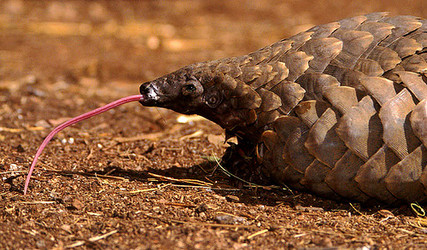Manidae
Pangolins and extinct relatives
- Eurotamandua

- Maninae
- Eomanis

- Necromanis

- Patriomanis

- Manis (Manis) crassicaudata
- Manis (Manis) pentadactyla (Chinese pangolin)
- Manis (Paramanis) javanica
- Eomanis
- Smutsiinae (African pangolins)
- Manis (Smutsia) gigantea (giant pangolin)
- Manis (Smutsia) temminckii (Cape pangolin)
- Manis (Phataginus) tricuspis (African tree pangolin)
- Manis (Uromanis) tetradactyla (Four-toed pangolin)
References
Barlow, J. C. 1984. Xenarthrans and Pholidotes. Pages 219-239 in Orders and Families of Recent Mammals of the World. (S. Anderson and J. K. Jones, Jr., eds.) John Wiley and Sons, New York.
Bugge, J. 1979. Cephalic arterial pattern in New-World edentates and Old-World pangolins with special reference to their phylogenetic-relationships and taxonomy. Acta Anatomica 105:37-46.
Chakrabarti, S., S. Bhattacharyya, and A. Chakrabarti. 1982. Somatic chromosomes of pangolin, Manis pentadactyla (Pholidota, Mammalia) with special reference to satellite association. Cytologia 47:625-629.
Gaudin, T. J. and J. R. Wible. 1999. The entotympanic of pangolins and the phylogeny of the Pholidota. Journal of Mammalian Evolution 6:39-65.
Gebo, D. L. and D. T. Rasmussen. 1985. The earliest fossil pangolin (Pholidota, Manidae) from Africa. Journal of Mammalogy 66:538-541.
McKenna, M. C. and S. K. Bell. 1997. Classification of Mammals Above the Species Level. Columbia University Press, New York.
Nowak, R.M. 1999. Walker's Mammals of the World. Sixth Edition. Volume II. Johns Hopkins University Press, Baltimore.
Pickford, M. and B. Senut. 1991. The discovery of a giant pangolin in the Pliocene of Uganda. Comptes Rendus de l'Academie des Sciences Serie II 313:827-830
Von Koenigswald, W. and T. Martin. 1990. A skeleton of Necromanis franconica, a pangolin (Pholidota, Mammalia) of the Aquitan from Saulcet in the Allier Basin (France). Ecologae Geologicae Helvetiae 83:845-864.
Information on the Internet
- IUCN Pangolin Specialist Group
- Order: Pholidota. Animal Diversity Web. University of Michigan Museum of Zoology.
- Pangolin. African Wildlife Foundation.
Title Illustrations

| Scientific Name | Manis (Smutsia) temminckii |
|---|---|
| Location | captive at Johannesburg Zoo, South Africa |
| Comments | A sad story with a great end. This guy was rescued from the illegal animal trade. The shangomas use the parts of these animal to preare muti - "healing" medicine. One of its scales can sell for as much as R20. Luckily this sub-adult was rescued and send to Johannesburg zoo where he recuperated fully. This picture was taken while he still had pneumonia - note the froth on his nose. This was the first and only time in my life I was privileged to see the "rare" creature. We have never seen one in the wild. They can walk on their hindlegs, using the tail as balancing mechanism. Their only defence is to roll into a tight ball. If picked up, they flick the tail and the scales can inflict lacerations. He was released back into the wild. |
| Acknowledgements | source: flickr: Pangolin - Manis temminckii |
| Specimen Condition | Live Specimen |
| Source Collection | Flickr |
| Copyright |
© 2006 Callie de Wet

|
About This Page
Page copyright © 2000
All Rights Reserved.
Citing this page:
Tree of Life Web Project. 2000. Manidae. Pangolins and extinct relatives. Version 01 January 2000 (temporary). http://tolweb.org/Manidae/16272/2000.01.01 in The Tree of Life Web Project, http://tolweb.org/








 Go to quick links
Go to quick search
Go to navigation for this section of the ToL site
Go to detailed links for the ToL site
Go to quick links
Go to quick search
Go to navigation for this section of the ToL site
Go to detailed links for the ToL site